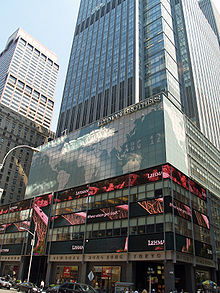2008
2008 in general
The monoline insurance companies (AMBAC, MBIA, ACA, &c) have written vast quantities of insurance against the failure of CDO tranches. Those tranches now begin to fail by the hundreds. The credit ratings agencies downgrade the monolines from AAA, but the monolines have a unique business model. If they don't have a AAA rating, then their main line of business (municipal bond insurance for city infrastructure projects) becomes impossible for them to perform. By 2009, the monolines have all crashed. [116] [192] [193] [194] [195] [196]
January 2008 to August 2008

Financial crisis escalates with collapse of major lenders and investors.
- January 2–21: January 2008 stock market downturn.
- January 24: The National Association of Realtors (NAR) announces that 2007 had the largest drop in existing home sales in 25 years, [197] and "the first price decline in many, many years and possibly going back to the Great Depression." [198]
- February 7: The market for auction rate securities freezes up—investors decline to bid.
- March 1–June 18: 406 people are arrested for mortgage fraud in an FBI sting across the U.S., including buyers, sellers and others across the wide-ranging mortgage industry. [199]
- March 10: Dow Jones Industrial Average at the lowest level since October 2006, falling more than 20% from its peak just five months prior.
- March 14: Bear Stearns gets Fed funding as shares plummet. [200]
- March 16: Bear Stearns is acquired for $2 a share by JPMorgan Chase in a fire sale avoiding bankruptcy. The deal is backed by the Federal Reserve, providing up to $30B to cover possible Bear Stearn losses. [201]
- May 6: UBS AG Swiss bank announces plans to cut 5500 jobs by the middle of 2009. [202]
- June 18: As the chairman of the Senate Banking Committee Connecticut's Christopher Dodd proposes a housing bailout to the Senate floor that would assist troubled subprime mortgage lenders such as Countrywide Bank, Dodd admitted that he received special treatment, perks, and campaign donations from Countrywide, who regarded Dodd as a "special" customer and a "Friend of Angelo". Dodd received a $75,000 reduction in mortgage payments from Countrywide. [203] [204] The Chairman of the Senate Finance Committee Kent Conrad and the head of Fannie Mae Jim Johnson also received mortgages on favorable terms due to their association with Countrywide CEO Angelo R. Mozilo. [203] [205]
- June 19: Cioffi and Tannin, managers of the Bear Stearns CDO hedge funds that crashed in 2007, are arrested by the Federal Bureau of Investigation. They are accused of misrepresenting their funds true condition to investors; both are acquitted. [206]
- July 11 Indymac Bank, a subsidiary of Independent National Mortgage Corporation (Indymac), is placed into the receivership of the Federal Deposit Insurance Corporation by the Office of Thrift Supervision. It was the fourth-largest bank failure in United States history, [207] and the second-largest failure of a regulated thrift. [208] [209] Before its failure, IndyMac Bank was the largest savings and loan association in the Los Angeles area and the seventh-largest mortgage originator in the United States. [210]
- July 14: Barney Frank characterizes future prospects of Fannie Mae and Freddie Mac as "solid" going forward.
- July 17: Major banks and financial institutions had borrowed and invested heavily in mortgage backed securities and reported losses of approximately $435 billion as of 17 July 2008. [211]
- July 30: President Bush signs into law the Housing and Economic Recovery Act of 2008, which authorizes the Federal Housing Administration to guarantee up to $300 billion in new 30-year fixed rate mortgages for subprime borrowers if lenders write-down principal loan balances to 90 percent of current appraisal value.
September 2008
- September 7: Federal takeover of Fannie Mae and Freddie Mac, which at that point owned or guaranteed about half of the U.S.'s $12 trillion mortgage market, effectively nationalizing them. This causes panic because almost every home mortgage lender and Wall Street bank relied on them to facilitate the mortgage market and investors worldwide owned $5.2 trillion of debt securities backed by them. [212] [213]
- September 14: Merrill Lynch is sold to Bank of America amidst fears of a liquidity crisis [214] and Lehman Brothers collapses after bids to purchase the company by Bank of America and Barclays fail. [215]
- September 15: Lehman Brothers files for Chapter 11 bankruptcy protection, holding $613 billion in assets. It remains the largest bankruptcy filing in US history. [216]
- September 16: Moody's and Standard and Poor's downgrade ratings on AIG's credit on concerns over continuing losses to mortgage-backed securities, sending the company into fears of insolvency. [217] [218] In addition, the Reserve Primary Fund "breaks the buck" leading to a run on the money market funds. Over $140 billion is withdrawn vs. $7 billion the week prior. This leads to problems for the commercial paper market, a key source of funding for corporations, which suddenly could not get funds or had to pay much higher interest rates. [219]
- September 17: The US Federal Reserve lends $85 billion to American International Group (AIG) to avoid bankruptcy.
- September 18: Treasury Secretary Henry Paulson and Fed Chairman Ben Bernanke meet with key legislators to propose a $700 billion emergency bailout through the purchase of toxic assets. Bernanke tells them: "If we don't do this, we may not have an economy on Monday." [220]
- September 19: Paulson financial rescue plan is unveiled after a volatile week in stock and debt markets.
- September 23: The Federal Bureau of Investigation discloses that it had been investigating the possibility of fraud by mortgage financing companies Fannie Mae and Freddie Mac, Lehman Brothers, and insurer American International Group, bringing to 26 the number of corporate lenders under investigation. [221]
- September 25: Washington Mutual is seized by the Federal Deposit Insurance Corporation, and its banking assets are sold to JP MorganChase for $1.9 billion.
- September 29: Emergency Economic Stabilization Act is defeated 228–205 in the United States House of Representatives; Federal Deposit Insurance Corporation announces that Citigroup Inc. would acquire banking operations of Wachovia. [222]
- September 30: US Treasury changes tax law to allow a bank acquiring another to write off all of the acquired bank's losses for tax purposes [223]
October 2008
- October 1: The U.S. Senate passes HR1424, their version of the $700 billion bailout bill. [224]
- October 1: The financial crisis spreads to Europe. [225] [226]
- October 3: President George W. Bush signs the Emergency Economic Stabilization Act, creating a $700 billion Troubled Assets Relief Program to purchase failing bank assets. [227] It contains easing of the accounting rules that forced companies to collapse because of the existence of toxic mortgage-related investments. [228] Also key to winning GOP support was a decision by the Securities and Exchange Commission to ease mark-to-market accounting rules that require financial institutions to show the deflated value of assets on their balance sheets." [188] [229]
- October 3: Using tax law change made September 30, Wells makes a higher offer for Wachovia, scooping it from Citigroup [230]
- October 6–10: Worst week for the stock market in 75 years. The Dow Jones loses 22.1 percent, its worst week on record, down 40.3 percent since reaching a record high of 14,164.53 October 9, 2007. The Standard & Poor's 500 index loses 18.2 percent, its worst week since 1933, down 42.5 percent in since its own high October 9, 2007. [231]
- October 6: Fed announces that it will provide $900 billion in short-term cash loans to banks. [232]
- October 7: Fed makes emergency move to lend around $1.3 trillion directly to companies outside the financial sector. [233]
- October 7: The Internal Revenue Service (IRS) relaxes rules on US corporations repatriating money held overseas in an attempt to inject liquidity into the US financial market. The new ruling allows the companies to receive loans from their foreign subsidiaries for longer periods and more times a year without triggering the 35% corporate income tax. [88]
- October 8: Central banks in USA (Fed), England, China, Canada, Sweden, Switzerland and the European Central Bank cut rates in a coordinated effort to aid world economy. [234]
- October 8: Fed also reduces its emergency lending rate to banks by half a percentage point, to 1.75 percent. [235]
- October 8: White House considers taking ownership stakes in private banks as a part of the bailout bill. [236] Warren Buffett and George Soros criticized the original approach of the bailout bill. [237] [238]
- October 11: The Dow Jones Industrial Average caps its worst week ever with its highest volatility day ever recorded in its 112-year history. Over the last eight trading days, the DJIA has dropped 22% amid worries of worsening credit crisis and global recession. Paper losses now on US stocks now total $8.4 trillion from the market highs of the previous year. [88]
- October 11: The G7, a group of central bankers and finance ministers from the Group of Seven leading economies, meet in Washington and agree to urgent and exceptional coordinated action to prevent the credit crisis from throwing the world into depression. The G7 did not agree on the concrete plan that was hoped for. [88]
- October 14: Following a model initiated by the United Kingdom bank rescue package announced on October 8, [239] [240] the US taps into the $700 billion available from the Emergency Economic Stabilization Act and announces the injection of $250 billion of public money into the US banking system. The form of the rescue will include the US government taking an equity position in banks that choose to participate in the program in exchange for certain restrictions such as executive compensation. Nine banks agreed to participate in the program and will receive half of the total funds: 1) Bank of America, 2) JPMorgan Chase, 3) Wells Fargo, 4) Citigroup, 5) Merrill Lynch, 6) Goldman Sachs, 7) Morgan Stanley, 8) Bank of New York Mellon and 9) State Street. Other US financial institutions eligible for the plan have until November 14 to agree to the terms. [88]
- October 21: The US Federal Reserve announces that it will spend $540 billion to purchase short-term debt from money market mutual funds. The large amount of redemption requests during the credit crisis have caused the money market funds to scale back lending to banks contributing to the credit freeze on interbank lending markets. This government is hoping the injection will help unfreeze the credit markets making it easier for businesses and banks to obtain loans. The structure of the plan involves the Fed setting up four special purpose vehicles that will purchase the assets. [88]
November 2008
- November 4: Federal Reserve loans $133 billion through various credit facilities, 39% of which goes to two foreign institutions-German Irish Bank Depfa and Dexia Credit of Belgium. [173]
- November 12: Treasury Secretary Paulson abandons plan to buy toxic assets under the $700 billion Troubled Asset Relief Program (TARP). Mr. Paulson said the remaining $410 billion in the fund would be better spent on recapitalizing financial companies. [88]
- November 15: The group of 20 of the world's largest economies meets in Washington DC and releases a statement of the meeting. Although no detailed plans were agreed upon, the meeting focused on implementing policies consistent with five principles: strengthening transparency and accountability, improving regulation, promoting market integrity, reinforcing cooperation and reforming international institutions. [88]
- November 17: The Treasury gives out $33.6 billion to 21 banks in the second round of disbursements from the $700 billion bailout fund. This payout brings the total to $158.56 billion so far. [241]
- November 24: The US government agrees to rescue Citigroup after an attack by investors causes the stock price to plummet 60% over the last week under a detailed plan that including injecting another $20 billion of capital into Citigroup bringing the total infusion to $45 billion. [241]
- November 25: The US Federal Reserve pledges $800 billion more to help revive the financial system. $600 billion will be used to buy mortgage bonds issued or guaranteed by Fannie Mae, Freddie Mac, and the Federal Home Loan Banks. [241]
- November 28: The Bank for International Settlements (BIS), the global organization behind the Basel Accord, issues a consultative paper providing supervisory guidance on the valuation of assets. The paper provides ten principles that should be used by banks to value assets at fair market value. [241]









